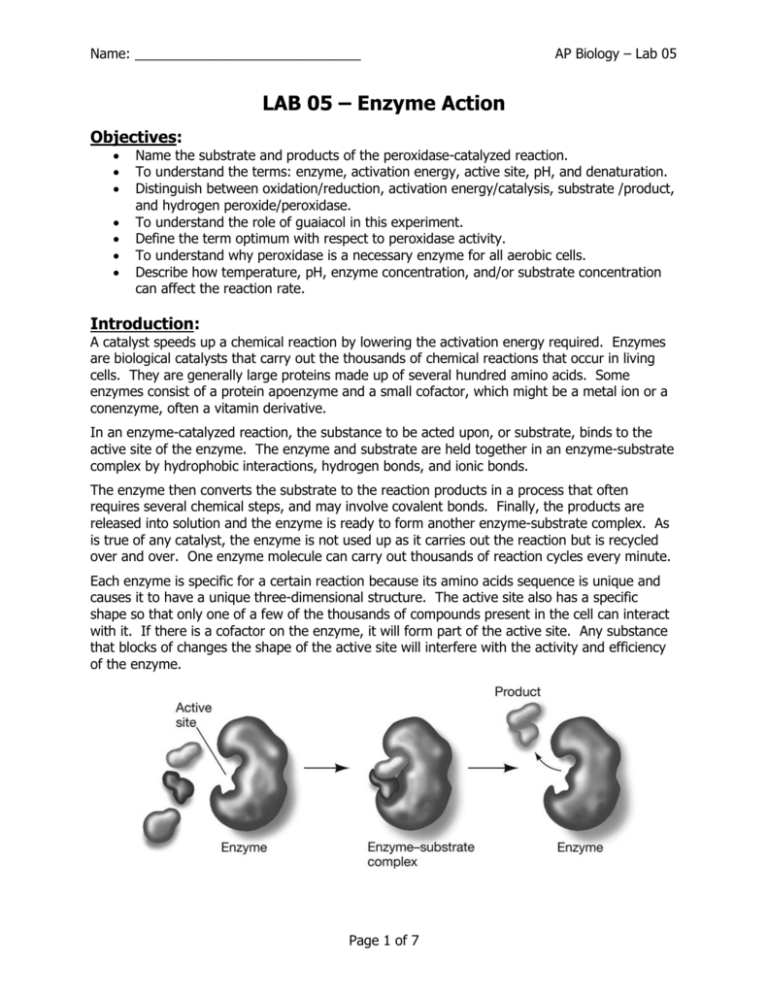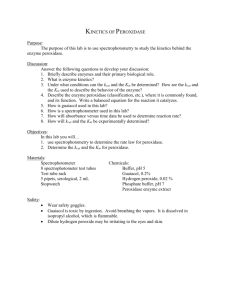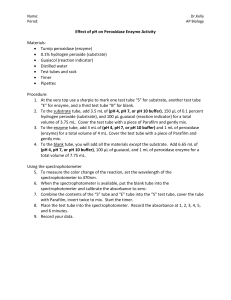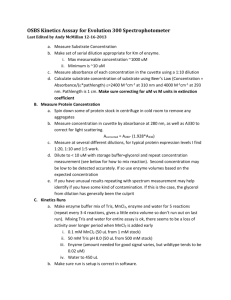LAB 05 - Enzyme Action
advertisement

Name: ______________________________ AP Biology – Lab 05 LAB 05 – Enzyme Action Objectives: Name the substrate and products of the peroxidase-catalyzed reaction. To understand the terms: enzyme, activation energy, active site, pH, and denaturation. Distinguish between oxidation/reduction, activation energy/catalysis, substrate /product, and hydrogen peroxide/peroxidase. To understand the role of guaiacol in this experiment. Define the term optimum with respect to peroxidase activity. To understand why peroxidase is a necessary enzyme for all aerobic cells. Describe how temperature, pH, enzyme concentration, and/or substrate concentration can affect the reaction rate. Introduction: A catalyst speeds up a chemical reaction by lowering the activation energy required. Enzymes are biological catalysts that carry out the thousands of chemical reactions that occur in living cells. They are generally large proteins made up of several hundred amino acids. Some enzymes consist of a protein apoenzyme and a small cofactor, which might be a metal ion or a conenzyme, often a vitamin derivative. In an enzyme-catalyzed reaction, the substance to be acted upon, or substrate, binds to the active site of the enzyme. The enzyme and substrate are held together in an enzyme-substrate complex by hydrophobic interactions, hydrogen bonds, and ionic bonds. The enzyme then converts the substrate to the reaction products in a process that often requires several chemical steps, and may involve covalent bonds. Finally, the products are released into solution and the enzyme is ready to form another enzyme-substrate complex. As is true of any catalyst, the enzyme is not used up as it carries out the reaction but is recycled over and over. One enzyme molecule can carry out thousands of reaction cycles every minute. Each enzyme is specific for a certain reaction because its amino acids sequence is unique and causes it to have a unique three-dimensional structure. The active site also has a specific shape so that only one of a few of the thousands of compounds present in the cell can interact with it. If there is a cofactor on the enzyme, it will form part of the active site. Any substance that blocks of changes the shape of the active site will interfere with the activity and efficiency of the enzyme. Page 1 of 7 Name: ______________________________ AP Biology – Lab 05 If these changes are large enough, the enzyme can no longer act at all, and is said to be denatured. There are several factors that are especially important in determining the enzyme‘s shape, and these are closely regulated both in the living organism and in laboratory experiments to give the optimum or most efficient enzyme activity: 1. 2. 3. 4. Temperature. All chemical reactions speed up as the temperature is raised. As the temperature increases, more of the reactive molecules have enough kinetic energy to undergo the reaction. Since enzymes are catalysts for chemical reactions, enzyme reactions also tend to go faster with increasing temperature. However, if the temperature of an enzyme-catalyzed reaction is raised still further, a temperature optimum is reached: above this point, the kinetic energy of the enzyme and water molecules is so great that the structure of the enzyme molecules starts to be disrupted. The positive effect of speeding up the reaction is now more than offset by the negative effect of denaturing more and more enzyme molecules. Many proteins are denatured by temperatures around 40-50C, but some are still active at 70-80C and a few can even withstand being boiled. pH. The pH scale, which is logarithmic, measures the acidity or H+ concentration in a solution. The scale runs form 0 to 14 with 0 being highest in acidity and 14 the lowest. When the pH is in the range of 0 – 7, a solution is said to be acidic; if the pH is around 7, the solution is neutral; and if the pH is in the range of 7 – 14, the solution is basic. Amino acids side chains contain groups such as –COOH and –NH2 that readily gain or lose H+ ions. As the pH is lowered, an enzyme will tend to gain H+ ions, and eventually enough side chains will be affected so that the enzyme‘s shape is disrupted. Likewise, as the pH is raised, the enzyme will lose H+ ions and eventually lose its active shape. Many enzymes have an optimum in the neutral pH range and are denatured at either extremely high or low pH. Some enzymes, such as those that act in the human stomach where the pH is very low, will have an appropriately low pH optimum. A buffer is a compound that will gain or lose H+ ions so that the pH changes very little. Salt concentration (salinity). If the salt concentration is very low or zero, the charged amino acids side chains of the enzyme molecules will ‗stick‘ together. The enzyme will denature and form an inactive precipitate. If, on the other hand, the salt concentration is very high, abnormal interactions will occur, and again the enzyme can again precipitate. An intermediate salt concentration such as that of blood (0.9%) or cytoplasm is the optimum for most enzymes. Other small molecules. Many molecules other than the substrate may interact with an enzyme. If such a molecule increases the rate of the reaction, it is an activator. If it decreases the reaction rate, then it is an inhibitor. The cell can use these molecules to regulate how fast the enzyme acts. Any substance that tends to unfold the enzyme, such as an organic solvent or detergent, will act as an inhibitor. Some inhibitors act by reducing the disulfide bridges that stabilize the enzyme‘s structure. Many inhibitors act by reacting with side chains in or near the active site to change or block it. Others may damage or remove the cofactor. Many well-known poisons such as potassium cyanide and curare are enzyme inhibitors that interfere with the active site of a critical enzyme. Page 2 of 7 Name: ______________________________ AP Biology – Lab 05 In this experiment, you will study the enzyme peroxidase obtained from turnips. Peroxidases are widely distributed in plant and animal cells and catalyze the oxidation or organic compounds by hydrogen peroxide as follows: peroxidase R-H + H2O2 R-OH + H2O Any cell using molecular oxygen in its metabolism will produce small amounts of H2O2 as a highly toxic by-product. It is critical that the H2O2 be quickly removed by enzymes such as peroxidase before it can do damage to the cell. You will use a reducing agent, guaiacol (structure shown below), which changes color when it is oxidized. This change can be easily measured in the spectrophotometer: peroxidase 4 guaiacol + 2H2O2 tetraguaiacol + 8H2O (colorless) (brown) A colored solution such as oxidized guaiacol solution appears that way because some of the light entering the solution is absorbed by the colored substance. A clear solution will allow almost all of the light to pass through. The amount of absorbance can be determined by using a spectrophotometer, which measures quantitatively what fraction of the light passes through a given solution, and indicates on the absorbance scale the amount of light absorbed compared to that absorbed by a clear solution. The darker the solution, the greater its absorbance. Inside the machine there is a light that shines through a filter (which can be adjusted to control the color or wavelength of light), then through the sample and onto a light-sensitive phototube. The phototube produces an electric current proportional to the amount of light striking it. The absorbance meter measures how much light has been blocked by the sample and thereby prevented from striking the phototube. A clear tube of water or other solvent is the blank and has zero absorbance. A solution that contains a small amount of a colored substance might show an absorbance of 0.1, a solution with a moderate amount of substance in solution might show an absorbance of 0.4, and so forth. In fact, in the lower portion of the absorbance scale, the amount of substance in solution is directly proportional to the absorbance reading so that a graph of absorbance versus concentration will give a straight line. This very useful relationship is known as Beer‘s law. Page 3 of 7 Name: ______________________________ AP Biology – Lab 05 Procedure: Preparation of Turnip Extract 1. Weigh out 5 g of turnip (the peeled, whitish inner portion) 2. Using a mortar and pestle, grind the turnip into pulp. 3. Combine with 200 mL of distilled water and blend at the high setting for 1 minute. NOTE: This suspension is the turnip extract, and contains the enzyme peroxidase. The activity of the turnip extract will vary from day to day, depending on the size and age of the turnip and the extent of the blending. PART I: Enzyme Action – Determining a Baseline (Protocol Demo) Baseline is a universal term for most chemical reactions. In this investigation the term is used to establish a standard for a reaction. Thus, when manipulating components of a reaction, you have a reference to help understand what occurred in the reaction. The baseline may vary with different scenarios pertinent to the design of the experiment, such as altering the environment in which the reaction occurs. In this scenario, different conditions can be compared, and the effects of changing an environmental variable can be determined. Rate can have more than one applicable definition because of different approaches, i.e., using a color palette (qualitative data) or a spectrophotometer (quantitative data) to measure percent of light absorbance. When using a color palette to compare the change in a reaction, you can infer increase, decrease, or no change in the rate; this inference is usually called the relative rate of the reaction. When using a spectrophotometer (or other measuring devices) to measure the actual percent change in light absorbance, the rate is usually referred to as absolute rate of the reaction. In this case, a specific amount of time can be measured, such as 0.083 absorbance/minute. Pipets will be used to measure accurately the solutions used in this experiment. BE SURE TO USE A DIFFERENT PIPET TIP FOR EACH STOCK SOLUTION SO THAT THE REAGENTS ARE NOT RUINED BY CROSS CONTAMINATION. 4. Label the pipets with tape or Sharpie™ so each one can be reused with the proper solution. 5. Obtain two spectrophotometer tubes (smaller ones – cuvettes) and label them B (blank) and R (reaction). 6. Obtain three of the larger test tubes and label them #1, #2, and #3. (#1 will contain a blank reaction without the substrate, H2O2. The contents of #2 and #3 will be mixed to start the reaction) 7. Set up the three tubes as follows with a total volume of 10 mL, and make a record of the contents of the reaction tube (the combined volumes of Tubes #2 and #3) in Figure 1. Tube #1: (blank tube without H2O2). Add 0.1 mL of guaiacol, 1.0 mL of turnip extract, and 8.9 mL of distilled water; mix well. Tube #2: Add 0.1 mL of guaiacol, 0.2 mL of 0.1% H2O2, and 4.7 mL of distilled water. Tube #3: Add 1.0 mL of turnip extract and 4.0 mL of distilled water. 8. Adjust the spectrophotometer to zero absorbance at 470 nm (the Amax for tetraguaiacol), using tube B filled with solution from test tube #1 filled approximately 2/3 full – set transmittance to 100% and remove tube. This now sets up the instrument so that any difference in the meter reading with a change in the sample will reflect a difference in oxidized guaiacol concentration. Page 4 of 7 Name: ______________________________ AP Biology – Lab 05 9. Obtain a stopwatch (or any other times), and be sure that you understand how to use it. 10. Prepare the sample: have ready spectrophotometer tube R, tissue/paper towel, and test tubes #2 and #3 filled with the solutions given above. YOU WILL HAVE 30 SECONDS TO MIX THE CONTENTS OF TUBES #2 AND #3, THEN FILL THE CUVETTE LABELED ―R‖ 2/3 FULL, WIPE THE OUTSIDE OF THE CUVETTE, AND TAKE THE FIRST READING. 11. When you are completely ready, mix the contents of tubes #2 and #3, pour the contents back and forth two times, and then pour quickly into tube ‗R‘; filling it approximately 2/3 full. Start the timer as soon as the tubes are mixed (t=0 seconds – when the tubes are mixed). 12. Wipe the outside of the tube and place it in the spectrophotometer. 13. Take your first reading at 30 seconds (t=30 seconds). Read the percent transmittance on the spec-20. Then, using the conversion table or formula from Lab 02, convert to absorbance. NOTE: At 0 seconds, the percent transmittance should be 100% (which means the absorbance is at 0). This was the exact moment the reaction started, so essentially, no substrate has been converted to product by the enzyme. 14. Continue to read the absorbance every 30 seconds for 5 minutes. 15. Record the readings in Table 1 and graph the absorbance versus time. This curve will represent the baseline of enzyme activity with which the enzyme activity under varying conditions will be compared. In the following experiments you will vary one condition at a time and compare the results with the base line. Check your graph with your instructor before proceeding with the rest of the experiment. PART I – Determining a Baseline (Protocol Demo) Table 1 – Data Obtained from Baseline Run (Demo). Time (seconds) %T A 0 100.0 0.0000 30 60 90 120 150 180 210 240 270 300 Page 5 of 7 Name: ______________________________ AP Biology – Lab 05 Results: PART II: Enzyme Action – Effect of a Variable Design and carry out an experiment to determine whether varying one aspect of the reaction or environmental conditions affects the rate of reaction. You will use the same procedure as PART I to set up a new baseline run. This must be carried out again because of the sensitive nature of enzymes. It is good practice to run your baseline at about the same time as your experimental runs so that the enzyme activity is the most similar. Preparation of Turnip Extract 16. Weigh out 5 g of turnip (the peeled, whitish inner portion) 17. Using a mortar and pestle, grind the turnip into pulp. 18. Combine with 200 mL of distilled water and blend at the high setting for 1 minute. 19. Repeat steps 4 – 15 from Part I. 20. For your experimental runs, the following procedure WILL have to be modified to accommodate what variable(s) you are testing. This might result in making multiple reaction tubes or having different quantities of the components added. You will need to figure this out with your group PRIOR to the start of lab. Do not forget that you will need a blank for the calibration of the spec-20… 21. Obtain two* spectrophotometer tubes (smaller ones – cuvettes) and label them B (blank) and R (reaction). 22. Obtain three* of the larger test tubes and label them #1, #2, and #3. (#1 will contain a blank reaction without the substrate, H2O2. The contents of #2 and #3 will be mixed to start the reaction.) 23. Set up each reaction tube that your group will be using with a total volume of 10 mL. Make a record of the contents of all reaction tubes used (the combined volumes of Tubes #2 and #3) in Figure 1. Remember, this is just a guideline – your group will be adjusting the contents of these tubes! Tube #1: (blank tube without H2O2). Add 0.1 mL of guaiacol, 1.0 mL of turnip extract, and 8.9 mL of distilled water; mix well. Tube #2: Add 0.1 mL of guaiacol, 0.2 mL of 0.1% H2O2, and 4.7 mL of distilled water. Tube #3: Add 1.0 mL of turnip extract and 4.0 mL of distilled water. 24. Adjust the spectrophotometer to zero absorbance at 470 nm (the Amax for tetraguaiacol), using tube B filled with solution from test tube #1 filled approximately 2/3 full – set transmittance to 100% and remove tube. This now sets up the instrument so that any difference in the meter reading with a change in the sample will reflect a difference in oxidized guaiacol concentration. 25. Obtain a stopwatch (or any other times), and be sure that you understand how to use it. 26. Prepare the samples and/or other external modifications for your experimental runs: have ready spectrophotometer tube R, tissue/paper towel, and test tubes #2 and #3 (for each reaction tube used). 27. When you are completely ready, mix the contents of tubes #2 and #3, pour the contents back and forth two times, and then pour quickly into tube R; approximately 2/3 full. Start the timer when the tubes are mixed (t=0 seconds – when the tubes are mixed). Page 6 of 7 Name: ______________________________ AP Biology – Lab 05 28. Wipe the outside of the tube and place it in the spectrophotometer. 29. Take your first reading at 30 seconds (t=30 seconds). Read the percent transmittance on the spec-20. Then, using the conversion table or formula from Lab 02, convert to absorbance. 30. Continue to read the absorbance every 30 seconds for 5 minutes. 31. Record the readings in Table 2 (NOT GIVEN – this needs to be designed by you and looks similar to Table 1) in your lab book. Methods: Baseline Variable 1 ______________ Variable 2 ______________ Variable 3 ______________ Contents Figure 1 – Contents of Reaction Tube Some Hints For Your Lab Report: The Introduction section of your lab should have your hypotheses for the variable that you are testing compared to the baseline. A visual hypothesis—a graph (sketched or Excel-ed)—may be included with your hypothesis. Make sure this is clearly stated (shown) in this section. DO NOT FORGET THE OTHER PARTS OF YOUR INTRODUCTION! The Methodology section of your report should have Figure 1, showing how the contents of the reaction tube is different in the variable you are changing… if applicable! It also needs to have a reproducible procedure that your group followed – not just a rehashing of how to set up the baseline reaction! The Results section of your lab report will include (but not be limited to): Table 2. (But it is your first table, so call it Table 1 in your report) Graph of data from Table 2. Properly formatted. Place all applicable lines on one graph – with R2 value. Page 7 of 7








